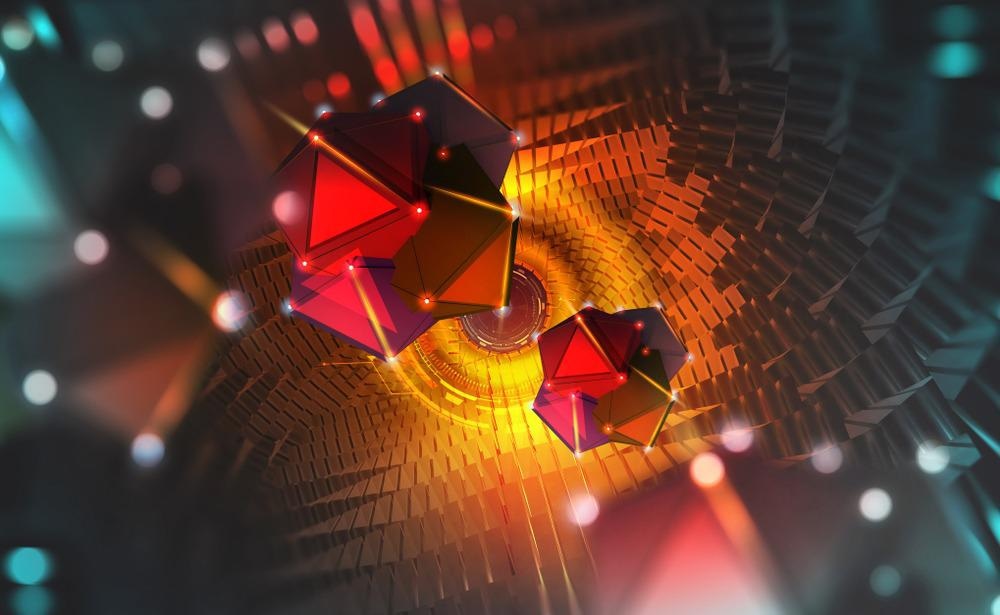Scientists have recently focussed on understanding the main factors associated with the assembly pathway of nanomaterials and its structural outcomes while developing nanocomposite materials. In a recent study, they studied two assembly regimes associated with quantum dots (QDs) and reversibly binding peptoids. This study is available as a pre-proof in the ACS Nano journal.

Study: Impact of Nanoparticle Size and Surface Chemistry on Peptoid Self-Assembly. Image Credit: Yurchanka Siarhei/Shutterstock.com
Development of Hybrid Nanomaterials
Researchers often organize nanomaterials hierarchically, mimicking natural systems to obtain unique functional properties, which can be utilized in various applications. It is imperative to understand atomic-level interactions to produce specific functional building blocks across length scales.
Typically, hybrid organic−inorganic nanomaterials are developed using a bottom-up assembly method or templated assembly on a scaffolding. In these systems, the organic molecules (e.g., DNA, peptides (or peptoids), and polymers) are utilized as structure-directing elements via covalent and non-covalent interactions, which can predict the possible assembly outcomes.
Scientists stated that these molecular interactions are based on a specific sequence used, which can be controlled via altering electrolytes, pH, solvent, temperature, etc. However, when inorganic nanoparticles are used as a driving force for assembly, the newly developed structures can be tuned by altering the nanoparticles' size, ligand packing, surface chemistry, and morphology.
Application of Peptoids as a Scaffold for Assembly of Hybrid Nanomaterials
Peptoids (poly-N-substituted glycines) are peptide analogs that are functionalized on nitrogen instead of carbon in the backbone sequence. Functionalization of the nitrogen enables the monomers to solubilize in several solvent systems. Owing to the lack of hydrogen bonding, the structure can be modified via sequences of the peptoid used by means of side-chain/side-chain and side-chain/backbone interactions.
Scientists stated that this peptide structure could assemble by itself and form a wide range of structures, for example, tubes, sheets, and helices.
Previously, researchers have used peptoids as a scaffold to assemble hybrid nanomaterials via post-synthesis addition of complementary nanoparticles to decorate the surface through covalent interactions. They assembled cadmium selenide (CdSe) nanoparticles onto peptoid tubes and sheets by establishing covalent bonding between CdSe nanoparticles and peptoid macrostructure via a thiol-maleimide click reaction.
Importance of Nanoparticle Size and Surface Chemistry for Peptoid Self-Assembly - A New Study
Recently, the same group of researchers has demonstrated the advantages of utilizing peptoid monomers as ligands on QDs to adjust assembly pathways bottom up. They revealed that the final hybrid nanomaterial structure exhibited the properties of QD based on its concentration, size and surface chemistry.
Scientists attached CdSe and CdS QDs to peptoid monomers to analyze their effect on varied functional groups on assembly. In this study, researchers used the peptoid monomers, which were composed of six hydrophobic residues (N-[2-(4-bromophenyl)ethyl]glycine, Nbrpe6Dig) with a carboxylic acid group at the end. Researchers selected this structure owing to its structural simplicity, limited steric bulk, and diverse solubility properties.
In the current study, the authors outlined two assembly regimes between QDs and peptoids that reversibly bind to the QD surface. In the first regime, the hybrid nanomaterial structures were controlled by both the peptoid and QD; however, in the second regime, the hybrid structures were dominated by inter-QD interactions.
Researchers studied the assembly pathway and progression of intermediates for peptoid-QD hybrid structures in aqueous and organic conditions. They found that the attachment of the QDs to the peptoid altered the solubility of the hybrid monomer unit, which assisted the assembly in organic conditions and stabilized intermediates in the aqueous system.
The hybrid monomers were synthesized using ligand exchange and were assembled. Scientists studied the resulting assemblies using ex-situ transmission electron microscopy as a function of assembly time. This study revealed the robust interaction between the peptoid monomer and the QD and observed a unique mechanism to attain equilibrium and decrease the heterogeneity in the number of peptoids attached to a specific number of QD. Scientists capped QDs with carboxylate ligands and have predicted equilibrium constant for the ligand.
Under aqueous conditions, QDs stabilized, and the final product consisted of multilayers of small peptoid sheets linked by QDs. Additionally, researchers observed that QDs were able to facilitate or impede assembly in organic solvents depending on the relative hydrophobicity of the surface ligands, which eventually determined the solubility of the hybrid monomer unit.
In the current study, an increase in the size of the QDs led to the production of large hybrid sheets with regions of highly ordered square-packed QDs. Furthermore, a second (smaller) QD species could be integrated to develop binary hybrid lattices.
Concluding Remarks
The current study helped create a set of design principles that will aid in controlling the structure and structural evolution of hybrid peptoid-QD assemblies. Some of the important factors explored in this study are the ratio of peptoid monomer relative to QD, hydrophobicity of the QD, and size of the QD. Scientists believe that understanding these factors would enable better manipulation of different QD parameters to generate specific hybrid architectures.
Reference
Monahan, M. et al. (2022) Impact of Nanoparticle Size and Surface Chemistry on Peptoid Self-Assembly. ACS Nano. https://pubs.acs.org/doi/10.1021/acsnano.2c01203
Disclaimer: The views expressed here are those of the author expressed in their private capacity and do not necessarily represent the views of AZoM.com Limited T/A AZoNetwork the owner and operator of this website. This disclaimer forms part of the Terms and conditions of use of this website.